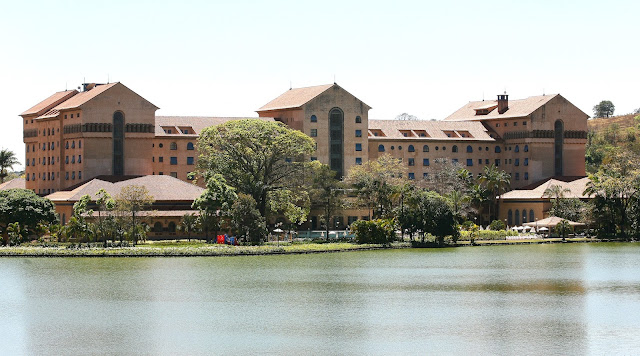 |
| Photo divulgação by Inhotim |
Instituto Inhotim is home to a museological complex featuring a series of pavilions and galleries with works of art and sculptures on display in the open air.
The Centro de Arte Contemporânea Inhotim is located in Brumadinho in the Brazilian state of Minas Gerais, founded by former mining magnate Bernardo Paz.
 |
| Art by Dan Graham via wikipedia |
 |
| Sculptures by Edgard de Souza via wikipedia |
 |
| Narcissus garden. Foto: wikipedia by Yayoi Kusama |
 |
| Jardins de Inhotim. Photo Google |
 |
| Jardins Inhotim. Photo Marco Mendes |
 |
| One of the restaurants of Inhotim. Photo by viagensdapaulete |
 |
| True Rouge by Tunga via wikipedia. Nets, blown glass, red ink, marine sponges, billiard balls and felts. |
"Nothing can prepare you for the breathtaking beauty of Inhotim, Brazil’s best-kept secret for lovers of contemporary art. Nestled in the remote southeastern town of Brumadinho (a 90-minute drive from the city of Belo Horizonte), Inhotim (pronounced IN-YO-TCHEEN) offers visitors a full-sensory unparalleled aesthetic experience.
A sprawling 5000 acres of lush botanical gardens (designed by Brazilian landscape artist Roberto Burle Marx) house approximately 500 works by 100 artists from 30 countries in over two dozen gallery pavilions. Arguably the finest outdoor contemporary art center in the world, Inhotim also boasts the world’s largest collection of palm trees (over 1500 different species); 4500 different exotic species of plants; gourmet restaurants; and works by the likes of Matthew Barney, Chris Burden, Janet Cardiff and George Miller, Anish Kapoor, and Brazilian superstar Tunga.
Inhotim’s installations demand direct participation between the viewer and the art object. It’s nearly impossible to have a passive viewing experience. On a massive lawn, for instance, hundreds of scattered pots in the shape of letters await patrons, who are encouraged to spell their names and then plant flowers inside them. Across the lake, a giant kaleidoscope by Danish artist Olafur Eliasson (“Viewing Machine”) offers a stunning vision of the mountainside."
Source: huffingtonpost
 |
| “Viewing Machine” by Olafur Eliasson. This work Olafur Eliasson based on the principles of operation of the kaleidoscope, generating an effect obtained by the reflection of light in six mirrors that form a hexagonal tube. The visitor is invited to handle this machine, pointing it at a point of interest, inside or outside the gallery space. Through the superposition of reflections, a myriad of shapes is disclosed. Photo by Zach Udko |
 |
| Photo divulgação Inhotim |
Opening hours
Park
Tuesday to friday: 9:30 a.m. to 4:30 p.m.
Saturday, sunday and holidays: 9:30 a.m. to 5:30 p.m.
Admission
Values
Tuesdays and Thursdays: R$ 25,00
Wednesdays (except for holidays): free admission
Fridays, Saturdays, Sundays and Holidays: R$40,00
Closed on Mondays.
Free entrance
Friends of Inhotim and children up to 5 years old.
Friends of Inhotim and children up to 5 years old.
For more information, visit www.inhotim.org.br.












